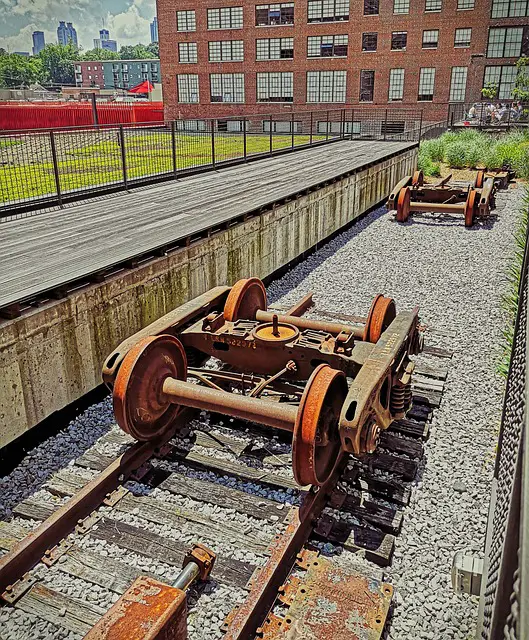A bogie is a vehicle chassis or undercarriage that carries the weight and bulk of the train. A locomotive is a vehicle with an engine that pulls or drives trains along railways.
Definition of bogie
(Image by Thomas H. from Pixabay )

A bogie is a chassis or framework carrying wheels, attached to a vehicle, either permanently or temporarily, utilizing a coupling. Bogies are used on rail vehicles including locomotives, carriages and wagons. A bogie in a railway vehicle generally constitutes two axle boxes placed close together.
There are three types of bogies:
- Rigid frame bogies,
- Swing frame bogies and
- Articulated frame bogies.
A rigid frame bogie is a single unit composed of two or more axles connected by side frames.
A swing frame bogie is composed of two axle boxes joined by a swivelling yoke that connects the centres of the wheelsets.
An articulated frame bogie contains two or more axles connected by hinged side frames.
The term “bogie” comes from the Scottish word “bog” meaning “soft ground”. The use of the term in relation to railway vehicles dates back to 1831 when it was used to describe an extra coach added to a train in order to accommodate more passengers.
Definition of locomotive
(Photo by Noel Jose on Unsplash )

A locomotive is a rail vehicle that provides the motive power for a train. The word locomotive originates from the Latin loco – “from a place”, ablative of locus, “place” + Medieval Latin motivus, “causing motion”, and is a shortened form of the term locomotive engine, which was first used in 1814 to distinguish between self-propelled and stationary steam engines.
There are several types of locomotive engines
- Steam locomotive – Produces its pulling power through a steam engine.
- Diesel locomotive – A diesel engines power source is a diesel engine with internal combustion
- Electric locomotive – is a locomotive powered by electricity
- Hybrid locomotive – uses a battery, a fueled power source and electrical engine.
- Gas turbine-electric locomotive – has a gas turbine which drives an electrical generator or alternator which in turn power traction motors
- Fuel cell-electric locomotive (hydrail) – This type of locomotive is powered by hydrogen
Bogies Vs. Locomotives – Key differences
Bogies and locomotives are both important components of trains, but they serve different functions and have distinct differences.
Function: Bogies, also known as trucks, are the part of the train that connects the wheels to the chassis and allows for the train to move along the tracks. Locomotives, on the other hand, are the engine that powers the train.
Size: Bogies are relatively small compared to locomotives, and there are typically several bogies on a single train. Locomotives, on the other hand, are much larger and often stand alone at the front or back of the train.
Power: Bogies do not generate power, but they do affect the stability and maneuverability of the train. Locomotives, on the other hand, generate the power needed to move the train along the tracks.
Design: Bogies are designed to provide stability and support to the train, and typically consist of wheels, axles, and suspension systems. Locomotives, on the other hand, have a more complex design that includes engines, boilers, and other components that generate and distribute power.
Maintenance: Bogies require regular maintenance to ensure that they remain stable and functioning properly. Locomotives require more extensive maintenance to keep the engine and other components in working order.
Bogies and locomotives have several key differences in function, size, power, design, and maintenance. While both are essential components of a train, they serve different purposes and have distinct characteristics.
Types of Bogies
There are several types of bogies used in trains, each designed for specific purposes. Here are some of the most common types:
Bolster bogies: These are the most basic type of bogie, consisting of two axles and a bolster to support the weight of the car or wagon.
Bar bogies: These bogies have two axles connected by a bar, which helps to distribute weight more evenly.
Jacobs bogies: Jacobs bogies have two sets of wheels that are connected by a shared suspension system, which provides better stability and reduces vibrations.
Radial bogies: These bogies have wheels that are mounted at an angle, which allows them to better negotiate curves in the track.
Floating bolster bogies: These bogies have a bolster that is suspended between the axles, which allows it to move independently of the axles and helps to reduce vibrations.
Bo-Bo bogies: These bogies have two sets of wheels that are mounted on a single frame, which allows for greater maneuverability and traction.
Co-Co bogies: Co-Co bogies have three sets of wheels mounted on a single frame, which provides even greater traction and stability.
The type of bogie used depends on the specific needs of the train and the terrain it will be traveling on.
Types of Locomotives
There are many different types of locomotives, each designed for specific purposes. Here are some of the most common types:
Steam locomotives: These were the first type of locomotive invented and were powered by steam engines. They are no longer in widespread use, but some vintage steam locomotives are still in operation for special events or tourist attractions.
Diesel locomotives: These are the most common type of locomotive in use today, and are powered by diesel engines. They are efficient, reliable, and easy to maintain, and can be used for a variety of purposes.
Electric locomotives: These locomotives are powered by electric motors and are typically used for passenger trains on electrified tracks. They are efficient, quiet, and environmentally friendly.
Hybrid locomotives: These locomotives combine both diesel and electric power, allowing for greater efficiency and flexibility.
High-speed trains: These trains are designed for high-speed travel, with speeds up to 300 km/h or more. They typically use electric or diesel-electric power, and are often used for intercity or high-speed rail travel.
Freight locomotives: These locomotives are designed for heavy-duty freight transport, with powerful engines and the ability to pull heavy loads.
Narrow-gauge locomotives: These locomotives are designed for use on narrow-gauge tracks, which are often used in mountainous or rugged terrain.
Rack-and-pinion locomotives: These locomotives have a special gear system that allows them to climb steep inclines, such as those found on mountain railways.
The type of locomotive used depends on the specific needs of the train and the type of service it will be providing.
Featured Image by Kalden Swart on Unsplash









